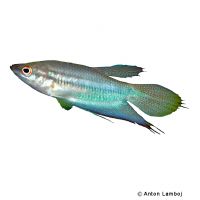Croaking Gourami (Trichopsis vittata)
| Croaking Gourami Trichopsis vittata | |
|---|---|
| Name | Croaking Gourami |
| Name Lat. | Trichopsis vittata |
| Synonym | Ctenops vittatus |
| Family | Gouramies |
| Family lat. | Osphronemidae |
| Order | Labyrinth Fishes |
| Order lat. | Anabantiformes |
| Origin | Southeast Asia |
| Habitat | Streams, floodplains |
| Diet | Carnivore |
| pH | 6.0-7.5 |
| Behavior | Peaceful |
| Keeping | Pair, group |
| Care Level | Moderate |
| Reproduction | Bubble nest builder |
| Breeding | Moderately difficult |
| Life Span | 3-5 years |
| Protection | No |
| Metric Units | |
| Size | 7 cm |
| Temperature | 22-28 °C |
| Hardness | 1-15 °dH |
| Aquarium | ~ 80 l |
| US Units | |
| Size | 2.8" |
| Temperature | 72-82 °F |
| Hardness | 18-267 ppm |
| Aquarium | ~ 20 gal |
Distribution and habitat
The distribution area of the Growling Gurami is the middle and lower Mekong basin in Laos, Thailand and Cambodia. There they live mostly in stagnant, low-oxygen waters, such as ponds, irrigation ditches, rice fields and floodplains with sometimes dense vegetation.
Maintenance
The aquarium should have dense planting with many hiding places (stones, roots). A dark substrate with foliage (sea almond leaves) as well as subdued light (floating plants) and soft, slightly acidic water is ideal.
No ammonia, ammonium or nitrite should be detectable, and the nitrate value should not exceed 100 mg/l. To ensure water quality and oxygen content, a filter and heater adapted to the aquarium size is required, as well as lighting for the species-appropriate day-night rhythm of the animals.
Diet
In nature they feed mainly on insects and insect larvae. The food supply consists of live, frozen and dry food. For a balanced diet, feed once a day with a high-quality, protein-rich dry food (flakes, granules, micropellets) and with cyclops, moina, daphnia, artemia, mosquito larvae, etc. (live or frozen)
It is recommended to feed small portions several times a day. Only feed as much as will be eaten within a few minutes. A regular and varied diet promotes health and increases resistance.
Behaviour and compatibility
These quiet and shy fish should be kept in pairs or a small group. Males are occasionally territorial within the species. Socialization with other small and calm fish is possible, but it is better to keep them in a species tank.
In principle, only mutually compatible fish species with similar requirements to the water condition and water temperature may be socialized.
Sex dimorphism
Males are more intensely colored and have a red fringe on the anal fin.
Reproduction and breeding
The male builds a loose foam nest, often on the underside of large water plant leaves, and also takes care of the brood. The eggs ejected during the numerous matings (entwinements) rise to the water surface, are collected by the male and introduced into the nest. The larvae hatch after 24-36 hours and swim freely after only 2-3 days.
The fry must be fed several times a day with special rearing food (dust food, Artemia nauplii). In a community tank breeding is hardly possible, because the fry are easy prey
Important
They have an additional respiratory organ, the so-called labyrinth (suprabranchial organ) with which they breathe atmospheric air and can suffocate if this is not possible. The air temperature in the breathing area must not be below the water temperature!
The thread-like extended ventral fins serve the chemical perception (taste stimuli)
In excitement they make well audible growling sounds. Intraspecific aggression is only observed in too small, sparsely furnished tanks.
The well-being of the fish should be checked regularly. Temperature should be checked daily, pH, hardness and nitrate levels should be checked at least every 14 days. Regular partial water changes are recommended, even when contaminant levels have not yet reached the upper limit. Sudden changes in water quality should be avoided. Newly introduced fish must be accustomed slowly to the water in the aquarium.
Further literature can be found in your pet store.
References
Text: petdata; Image: Anton Lamboj
Source: BMEL (1998): Tierschutzgutachten - Haltung von Zierfischen (Süßwasser); RIEHL & BAENSCH (2006): Aquarien Atlas Bd. 1, Mergus Verlag; ENGELMANN (2005): Zootierhaltung - Tiere in menschlicher Obhut: Fische, Verlag Harri Deutsch
- Gemäß § 21 Abs. 5 Tierschutzgesetz idgF
